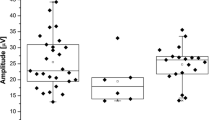Abstract
Purpose
The authors examined macular function in preterm-born children, using multifocal ERG (mfERG). Possible alterations in P1 amplitudes, P1 amplitudes density and P1 implicit time between school-age children with history of prematurity and their peers were researched. The correlations between parameters of mfERG responses and birth weight, gestational age, macular volume and central macular thickness were verified.
Methods
A group of 18 preterm-born school-age children were analyzed (mean age 10.18 ± 1.21 years). The study group was compared to the group of 15 peers born appropriate for gestational age (mean age 10.8 ± 1.52 years). The mfERG was evaluated in all children.
Results
There were statistically significant differences for P1 amplitudes from ring 1 (p = 0.0001) and P1 amplitudes density from ring 1 (p = 0.0001). Calculating the correlation coefficients, we receive significant results for P1 amplitudes from ring 1 versus gestational age (r = 0.54; p = 0.026), birth weight (r = 0.54; p = 0.026) and central macular thickness (r = −0.62; p = 0.008), and for P1 amplitudes density from ring 1 versus central macular thickness (r = −0.51; p = 0.034).
Conclusions
The study suggests that P1 amplitudes and P1 amplitudes density vary in preterm-born children in comparison with their peers born appropriate for gestational age, which might suggest discreet macular dysfunction. The correlation between low birth weight, early gestational age, central macular thickness and mFERG components from ring 1 might evidence that decreased bipolar cells density caused by premature birth is the result of altered development of central retina reflecting in structural anomalies of the fovea.





Similar content being viewed by others
References
Cavallaro G, Filippi L, Bagnoli P, La Marca G, Cristofori G, Raffaeli G, Padrini L, Araimo G, Fumagalli M, Groppo M, Dal Monte M, Osnaghi S, Fiorini P, Mosca F (2014) The pathophysiology of retinopathy of prematurity: an update of previous and recent knowledge. Acta Ophthalmol 92:2–20
Fanaroff AA, Stoll BJ, Wright LL et al (2007) Trends in neonatal morbidity and mortality for very low birth weight infants. Am J Obstet Gynecol 196:147
Wilson-Costello D, Friedman H, Minich N et al (2007) Improved neurodevelopmental outcomes for extremely low birth weight infants in 2000–2002. Pediatrics 119:37–45
Wood NS, Marlow N, Costeloe K et al (2000) Neurologic and developmental disability after extremely preterm birth. N Engl J Med 343:378–384
Koo KY, Kim JE, Lee SM et al (2010) Effect of severe neonatal morbidities on long term outcome in extremely low birthweight infants. Korean J Pediatr 53:694–700
Ecsedy M, Szamosi A, Karkó C, Zubovics L, Varsányi B, Németh J, Récsán Z (2007) A comparison of macular structure imaged by optical coherence tomography in preterm and full-term children. Investig Ophthalmol Vis Sci 48:5207–5211
Hammer DX, Iftimia NV, Ferguson RD, Bigelow CE, Ustun TE, Barnaby AM, Fulton AB (2008) Foveal fine structure in retinopathy of prematurity: an adaptive optics Fourier domain optical coherence tomography study. Investig Ophthalmol Vis Sci 49(5):2061–2070
Grun G (1982) The development of the vertebrate retina: a comparative survey. Adv Anat Embryol Cell Biol 78:1–85
Dorn EM, Hendrickson L, Hendrickson AE (1995) The appearance of rod opsin during monkey retina development. Investig Ophthalmol Vis Sci 36:2634–2651
Drucker DN, Hendrickson AE (1989) The morphological development of extrafoveal human retina. Investig Ophthalmol Vis Sci 30:226
Yuodelis C, Hendrickson A (1986) A qualitative and quantitative analysis of the human fovea during development. Vis Res 26:847–855
Hendrickson AE, Yuodelis C (1984) The morphological development of the human fovea. Ophthalmology 91:603–612
Hendrickson AE (1994) Primate foveal development: a microcosm of current questions in neurobiology. Investig Ophthalmol Vis Sci 35:3129–3133
Hendrickson AE (1994) The morphologic development of human and monkey retina. In: Albert DM, Jakobiec FA (eds) Principles and practice of ophthalmology: basic sciences. WB Saunders Co, Philadelphia, pp 561–577
Springer AD (1999) New role for primate fovea: a retinal excavation determines photoreceptor deployment and shape. Vis Neurosci 16:629–636
Provis JM, Sendercoe T, Hendrickson AE (2000) Astrocytes and blood vessels define foveal rim during primate retinal development. Investig Ophthalomol Vis Sci 41:2827–2836
Fulton AB, Hansen RM, Moskowitz A, Barnaby AM (2005) Multifocal ERG in subjects with history of retinopathy of prematurity. Doc Ophthalmol 111:7–13
Hood DC, Bach M, Brigell M, Keating D, Kondo M, Lyons JS, Marmor MF, McCulloch DL, Palmowski-Wolfe AM (2012) ISCEV Standard for clinical multifocal electroretinography (2011 edition). Doc Ophthalmol 124:1–13
Marmor MF, Fulton AB, Holder GE, Miyake Y, Brigell M, Bach M (2009) Standard for clinical electroretinography (2008 update). Doc Ophthalmol 118:69–77
Wu WC, Lin RI, Shih CP et al (2012) Visual acuity, optical components, and macular abnormalities in patients with a history of retinopathy of prematurity. Ophthalmology 119(9):1907–1916
Ruberto G, Redaelli C, Cataldo S et al (2004) Compared progression of visual evoked potentials in preterm and term newborns. J Fr Ophtalmol 27:1031–1038
Michalczuk M, Urban B, Chrzanowska-Grenda B et al (2015) An influence of birth weight, gestational age, and apgar score on pattern visual evoked potentials in children with history of prematurity. Neural Plast 2015, Article ID 754864
Candy TR, Crowell JA, Banks MS (1998) Optical, receptoral, and retinal constraints on foveal and peripheral vision in the human neonate. Vis Res 38:3857–3870
Hansen RM, Moskowitz A, Fulton AB (2009) Multifocal ERG responses in infants. Investig Ophthalmol Vis Sci 50:470–475
Recchia FM, Recchia CC (2007) Foveal dysplasia evident by optical coherence tomography in patients with a history of retinopathy of prematurity. Retina 27:1221–1226
Dale EA, Hood DC, Greenstein VC, Odel JG (2010) A comparison of multifocal ERG and frequency domain OCT changes in patients with abnormalities of the retina. Doc Ophthalmol 120:175–186
Author information
Authors and Affiliations
Corresponding author
Ethics declarations
Conflict of interest
All authors certify that they have no affiliations with or involvement in any organization or entity with any financial interest (such as honoraria; educational grants; participation in speakers’ bureaus; membership, employment, consultancies, stock ownership, or other equity interest; and expert testimony or patent-licensing arrangements), or non-financial interest (such as personal or professional relationships, affiliations, knowledge or beliefs) in the subject matter or materials discussed in this manuscript.
Ethical approval
All procedures performed in studies involving human participants were in accordance with the ethical standards of the institutional research committee and with the 1964 Declaration of Helsinki and its later amendments or comparable ethical standards.
Informed consent
Informed consent was obtained from the parents of all children included in the study.
Rights and permissions
About this article
Cite this article
Michalczuk, M., Urban, B., Chrzanowska-Grenda, B. et al. The assessment of multifocal ERG responses in school-age children with history of prematurity. Doc Ophthalmol 132, 47–55 (2016). https://doi.org/10.1007/s10633-016-9526-1
Received:
Accepted:
Published:
Issue Date:
DOI: https://doi.org/10.1007/s10633-016-9526-1




